学校代号 10532 学 号 S1124W116
分 类 号 TP391 密 级 普通
工程硕士学位论文
基于 OpenGL 的三维模型简化
算法的研究与实现
学位申请人姓名 张非凡
培 养 单 位 信息科学与工程学院
导师姓名及职称 常炳国副教授 王祥宗高级工程师
学 科 专 业 软件工程
研 究 方 向 计算机图形学
论 文 提 交 日 期 2015 年 4 月 30 日
�
学校代号:10532
号:S1124W116
级:普通
学
密
湖南大学工程硕士学位论文
基于 OpenGL 的三维模型简化
算法的研究与实现
学位申请人姓名:张非凡
导师姓名及职称:常炳国副教授 王祥宗高级工程师
培 养 单 位:信息科学与工程学院
专 业 名 称:软件工程
论 文 提 交 日 期:2015 年 4 月 30 日
论 文 答 辩 日 期:2015 年 5 月 30 日
答辩委员会主席:杨贯中教授
�
Research and Implementation on Simplified Scheme of
Three-dimensional Model Based on OpenGL
by
ZHANG Feifan
B.E. (Hunan University) 2011
A thesis submitted in partial satisfaction of the
Requirements for the degree of
Master of Engineering
in
Software Engineering
in the
Graduate School
of
Hunan University
Supervisor
Associate Professor CHANG Bingguo
Senior Engineer WANG Xiangzong
May, 2015
�
工程硕士学位论文
学位论文原创性声明和学位论文版权使用授权书
湖 南 大 学
学位论文原创性声明
本人郑重声 明:所 呈交的论文 是本人 在导师的指 导下独 立进行研究 所
取得的研究成果。除了文中特别加以标注引用的内容外,本论文不包含任何
其他个人或集体已 经发表或撰写的成 果作品。对本文的 研究做出重要贡献
的个人和集体,均已在文中以明确方式标明。本人完全意识到本声明的法律
后果由本人承担。
作者签名:
日期: 年 月 日
学位论文版权使用授权书
本学位论文作者完全了解学校有关保留、使用学位论文的规定,同意学
校保留并向国家有 关部门或机构送交 论文的复印件和电 子版,允许论文被
查阅和借阅。本人 授权湖南大学可以 将本学位论文的全 部或部分内容编入
有关数据库进行检索,可以采用影印、缩印或扫描等复制手段保存和汇编本
学位论文。
本学位论文属于
1、保密□,在______年解密后适用本授权书。
2、不保密□。
(请在以上相应方框内打“√”)
作者签名:
导师签名:
日期: 年 月 日
日期: 年 月 日
I
�
基于 OpenGL 的三维模型简化算法的研究与实现
摘 要
大型数据的可视化及实时显示已在诸多领域得到广泛的运用,如虚拟现实技
术、三维动画、游戏制作等,三维实体显示技术已成为领域研究热点。随着三维
建模及数据获取等相关技术的发展、以及为了提高模拟显示的效果,三维模型变
得越来越复杂精细,这些模型的三角网格数据往往包含数十万或数百万个面片,
有的甚至达到了上亿。这种三维模型复杂、数据量大的特点使得模型存储难、传
输难、绘制难,也给人机交互带来了巨大的挑战。采用模型简化算法对网格模型
进行简化并保留其相关的几何特征具有十分重要的意义。
论文首先对模型简化方法进行了有意义的探索,研究了几何元素删除法、顶
点聚类法、采样法、自适应细分法这四类基本模型简化算法特点。在此基础上本
文进一步研究了 QEM 边折叠算法。为了解决 QEM 边折叠算法在对模型高度简化
时无法保留三维模型细节特征的缺陷,本文提出了一种基于法向量误差和体积误
差的边折叠算法。该算法采用蝶形插值细分法计算边折叠后新顶点的空间位置,
根据新顶点的空间位置计算边折叠时简化网格的顶点法向量和模型体积误差并建
立折叠序列,成功在模型的高曲率区和低曲率区实现对网格模型的简化。因此本
文算法既考虑到了简化模型的体积变化,又能够很好地反映网格局部曲面的几何
变化。接着算法通过实现渐进网格方法,实现了对网格模型的动态简化。最后本
论文在 Visual Studio 2010 平台上,结合 OpenGL 开发了一个三维模型简化软件,
并把改进前后的算法集成到了该软件当中进行对比,并对本文算法的简化效果进
行验证。该软件可以处理 PLY 格式的模型文件,并实现了简单的人机交互和渲染
等功能。
实验结果表明,开发的基于 OpenGL 的三维模型简化软件能够成功导入并简
化 PLY 格式的三维模型文件,并且相较于 QEM 边折叠算法,改进后的边折叠算
法显示效果更好,模型的几何形状和细节特征得到较好的维持。该软件达到预期
研究目的,且运行良好。
关键词:网格简化;边折叠;法向量;体积误差
II
�
工程硕士学位论文
Abstract
Currently, large-scale data’s visualization and real-time display have been widely
used in many areas, such as virtual reality, video games and movies. Three-dimensional
solid display technology has become a hot area of research . With the development of
three-dimensional modeling and data acquisition and other related technologies , and in
order to improve the effect of the analog display, three-dimensional model becomes
more complex. The triangular mesh data for these models often contain hundreds of
thousands or millions of facets, some models even reached millions. The features of
this three-dimensional model is complex and larger amount of data. This makes the
model becomes difficult to store, difficult to transport, difficult to draw, and it also
create huge challenges for Human–Machine Interaction. So how to simplify the mesh
model and retain the geometric features is very important.
This thesis simplified start a meaningful exploration of Model Simplification, and
study the characteristics of four basic model simplification algorithm s for geometric
element decimation, vertex clustering method, sampling method and adaptive
refinements. On this basis, this paper further studied the QEM edge collapse algorithm.
The QEM edge collapse algorithm can't retain the minutiae of three-dimensional model
when the model is highly simplified. In order to solve this defect, an edge collapse
simplification algorithm based on normal and volume error is presented in this paper.
The algorithm calculates the spatial location of the new vertex after edge collapse by
the butterfly-shaped interpolating subdivision, and then computes the vertex normal
and volume error of the simplified grid in edge co llapse according to the spatial
location of the new vertex and establishes a folding sequence, and at last carries out
the operation of edge collapse of the mesh model in the folding sequence, then the mesh
model is simplified in the high curvature and low curvature region. This algorithm not
only takes into account the volume changes of the simplified model, but also can well
reflect the changes in the geometry of local surface meshes. Then the algorithm can
dynamically simply the mesh model by implementing progressive mesh method.
Meanwhile, upon Visual Studio 2010 platform, developed a model to model
simplification software combined with the excellent three-dimensional graphics library
OpenGL, and two algorithms deletion into the software. This software can handle
models which are PLY file format, and has a simple human-computer interaction and
rendering functions.
III
�
基于 OpenGL 的三维模型简化算法的研究与实现
Experimental results show that the model-simplified software we develop based
on OpenGL can success import PLY files, and compared to the QEM edge collapse
algorithm, the improved edge collapse algorithm is better display the original algorit hm,
the geometry of the model get a better maintained. This model-simplified software
achieves our research purpose and running perfect.
Key Words: Mesh simplification; edge collapse; Normal; Volume Error
IV
�
工程硕士学位论文
目 录
学位论文原创性声明和学位论文版权使用授权书 ................................................... I
摘 要 ........................................................................................................................ II
Abstract .................................................................................................................... III
目 录 ........................................................................................................................ V
插图索引 ................................................................................................................. VII
插表索引 ................................................................................................................ VIII
第 1 章 绪 论 ..........................................................................................................1
1.1 研究背景及意义 .......................................................................................... 1
1.2 国内外研究的发展及现状 .......................................................................... 2
1.3 本文所做的主要工作 .................................................................................. 6
1.4 本文的章节安排 .......................................................................................... 6
第 2 章 边折叠网格模型简化算法 ...........................................................................8
2.1 三角网格模型 .............................................................................................. 8
2.1.1 三角网格的几何性质 ........................................................................... 8
2.1.2 三角面片的法向量 ............................................................................... 9
2.1.3 网格模型的数学描述 ......................................................................... 11
2.2 边折叠简化算法 ........................................................................................ 11
2.2.1 边折叠算法概述 ................................................................................. 11
2.2.2 QEM 边折叠代价 ................................................................................ 13
2.2.3 新顶点的位置 ..................................................................................... 14
2.2.4 算法步骤 ............................................................................................. 15
2.2.5 实验结果 ............................................................................................. 15
2.3 本章小结 ................................................................................................... 16
第 3 章 边折叠模型简化算法研究 ......................................................................... 17
3.1 三维模型动态简化的要求 ........................................................................ 17
3.2 改进的边折叠算法 .................................................................................... 18
3.2.1 法向量变化误差 ................................................................................. 19
3.2.2 体积变化误差 ..................................................................................... 20
3.2.3 新顶点的位置 ..................................................................................... 21
3.2.4 狭长三角形的控制 ............................................................................. 22
3.3 渐进网格 ................................................................................................... 22
3.3.1 渐进网格原理 ..................................................................................... 23
V
�

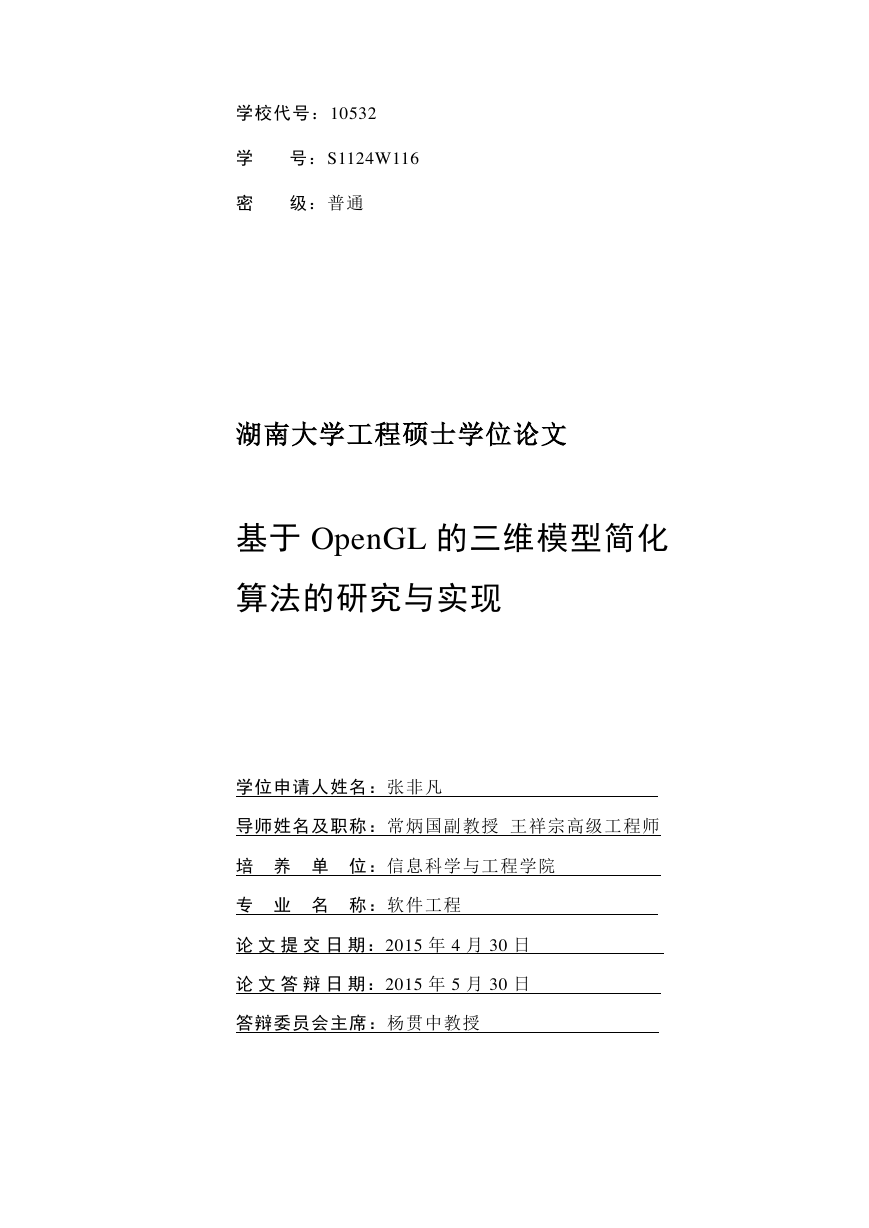
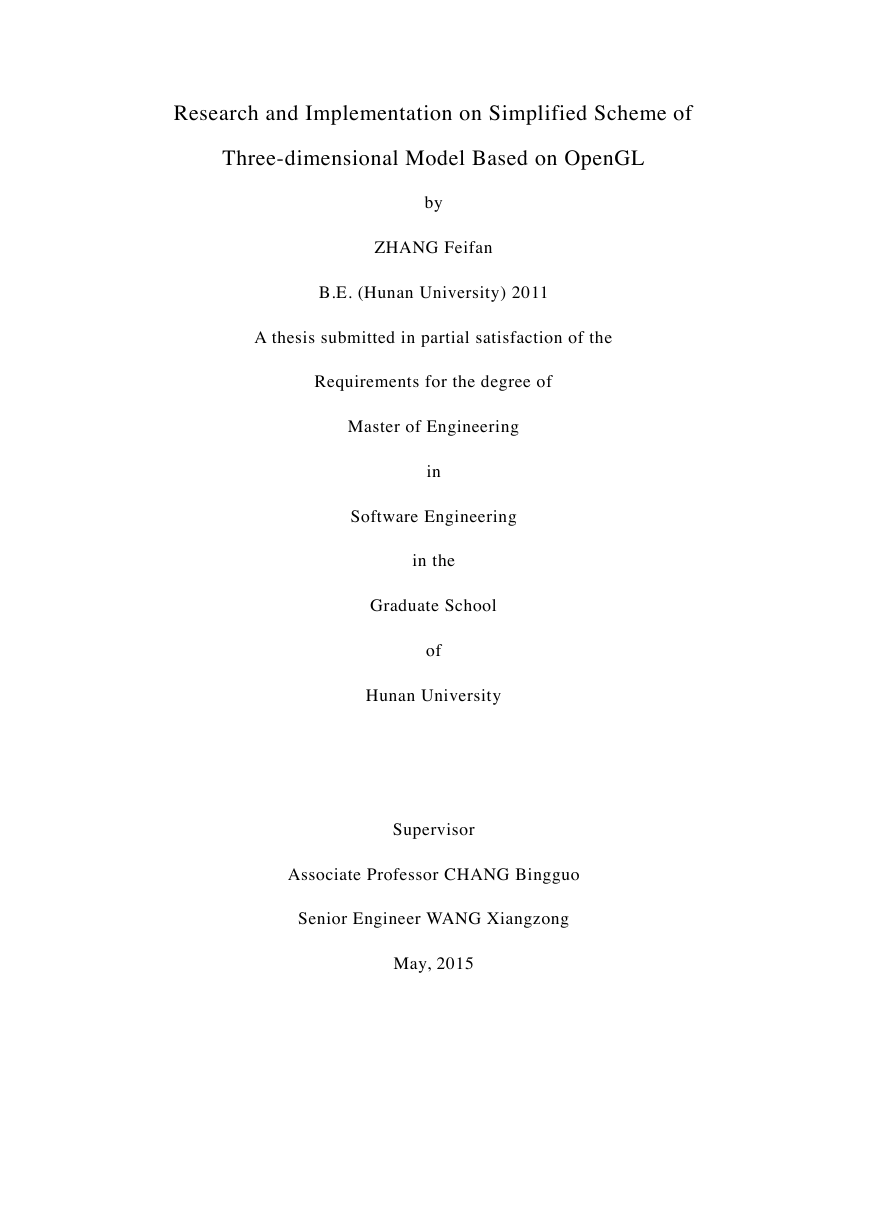


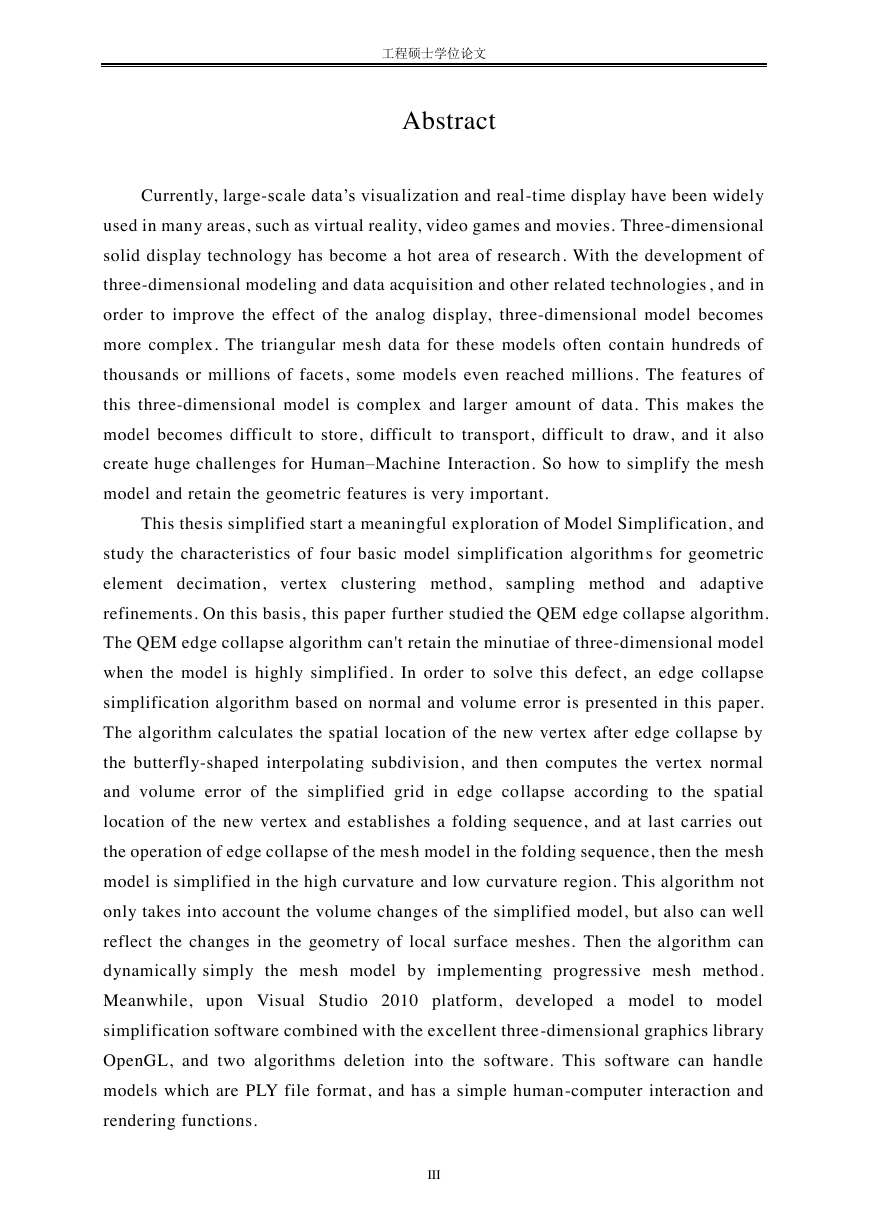
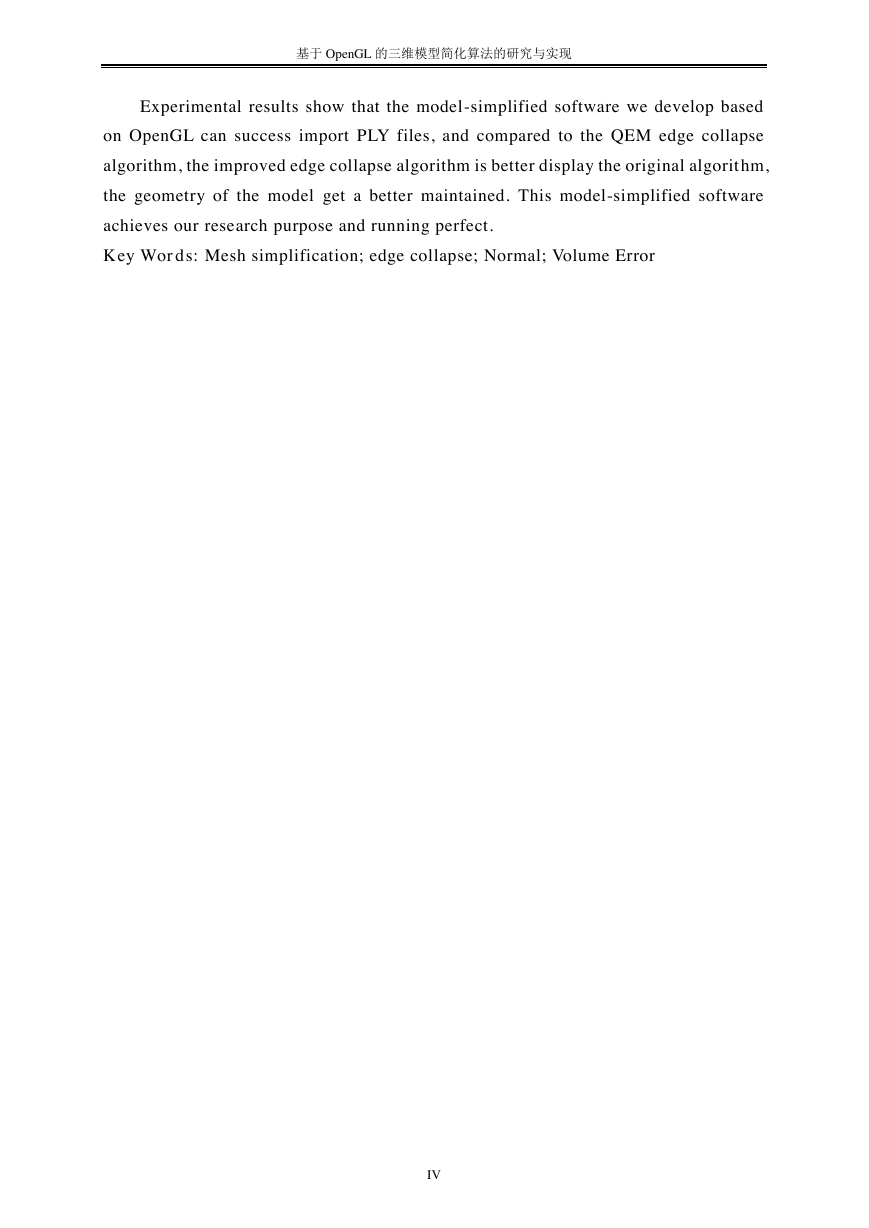
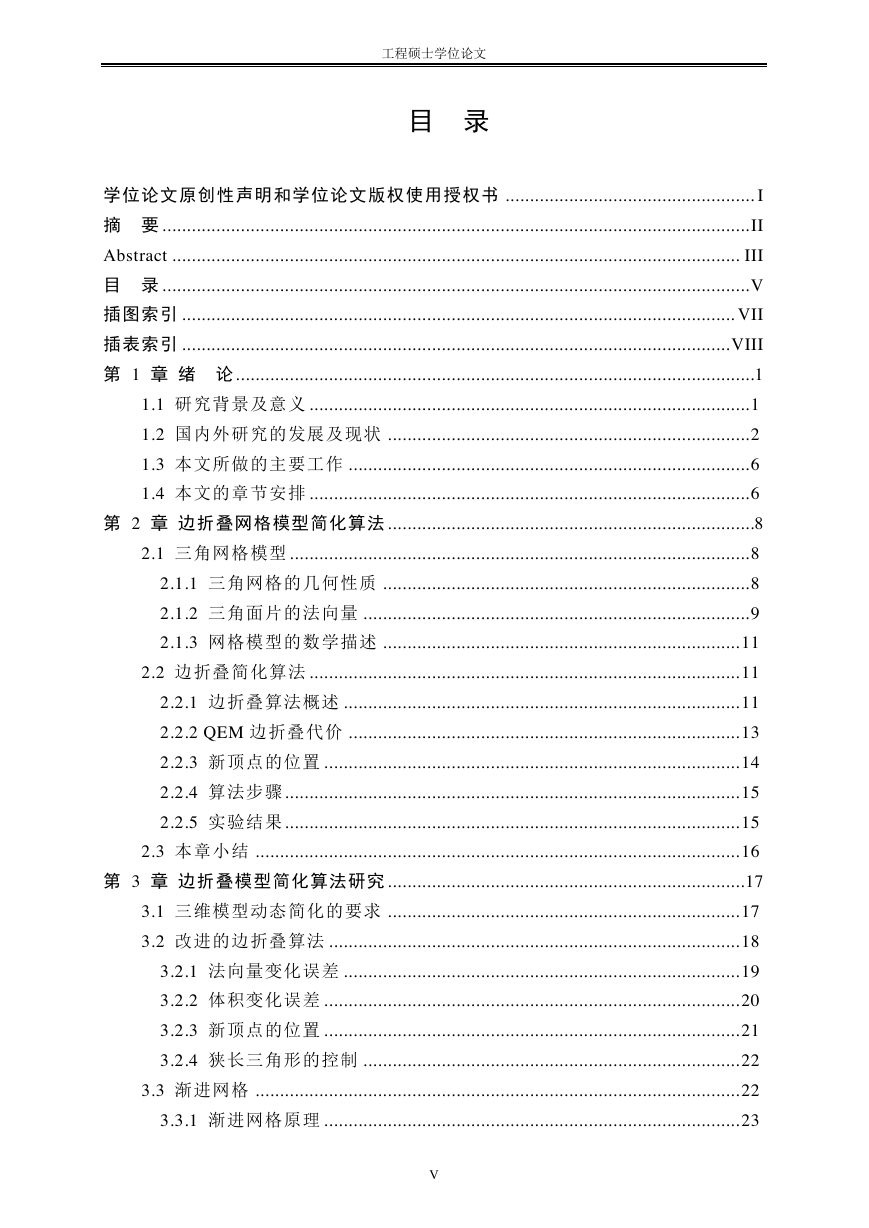








 2023年江西萍乡中考道德与法治真题及答案.doc
2023年江西萍乡中考道德与法治真题及答案.doc 2012年重庆南川中考生物真题及答案.doc
2012年重庆南川中考生物真题及答案.doc 2013年江西师范大学地理学综合及文艺理论基础考研真题.doc
2013年江西师范大学地理学综合及文艺理论基础考研真题.doc 2020年四川甘孜小升初语文真题及答案I卷.doc
2020年四川甘孜小升初语文真题及答案I卷.doc 2020年注册岩土工程师专业基础考试真题及答案.doc
2020年注册岩土工程师专业基础考试真题及答案.doc 2023-2024学年福建省厦门市九年级上学期数学月考试题及答案.doc
2023-2024学年福建省厦门市九年级上学期数学月考试题及答案.doc 2021-2022学年辽宁省沈阳市大东区九年级上学期语文期末试题及答案.doc
2021-2022学年辽宁省沈阳市大东区九年级上学期语文期末试题及答案.doc 2022-2023学年北京东城区初三第一学期物理期末试卷及答案.doc
2022-2023学年北京东城区初三第一学期物理期末试卷及答案.doc 2018上半年江西教师资格初中地理学科知识与教学能力真题及答案.doc
2018上半年江西教师资格初中地理学科知识与教学能力真题及答案.doc 2012年河北国家公务员申论考试真题及答案-省级.doc
2012年河北国家公务员申论考试真题及答案-省级.doc 2020-2021学年江苏省扬州市江都区邵樊片九年级上学期数学第一次质量检测试题及答案.doc
2020-2021学年江苏省扬州市江都区邵樊片九年级上学期数学第一次质量检测试题及答案.doc 2022下半年黑龙江教师资格证中学综合素质真题及答案.doc
2022下半年黑龙江教师资格证中学综合素质真题及答案.doc